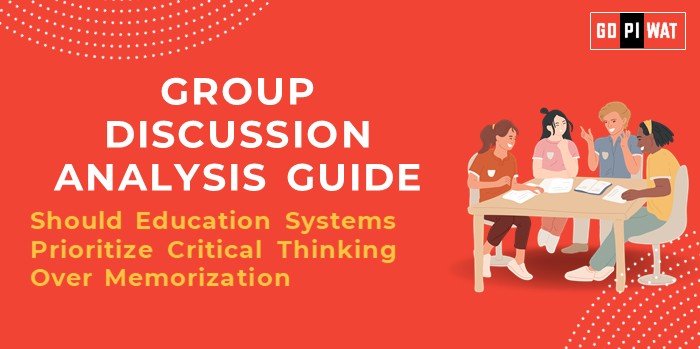📋 GD Guide: Should Education Systems Prioritize Critical Thinking Over Memorization?
🌐 Introduction to the Topic
Context: Education systems worldwide face a pivotal challenge—whether to emphasize critical thinking skills or traditional memorization.
Background: Historically, memorization-based learning suited earlier industrial societies, but modern economies increasingly demand analytical thinkers. Reports from global education frameworks highlight a trend towards fostering creativity and problem-solving in curricula.
📊 Quick Facts and Key Statistics
– 🌍 PISA Rankings: Countries prioritizing critical thinking, like Finland, rank higher in education quality compared to rote-heavy systems like those in South Asia.
– 🧠 Employability: 59% of employers consider problem-solving the most critical skill (LinkedIn Workforce Report, 2023).
– 🌐 Educational Trends: 70+ countries have adopted inquiry-based learning as part of their national curriculums.
👥 Stakeholders and Their Roles
- 🏛️ Government Bodies: Implement educational policies emphasizing critical thinking through teacher training and curriculum reforms.
- 🏫 Educational Institutions: Integrate innovative teaching methods, focusing on experiential learning and critical analysis.
- 👨👩👧👦 Students and Parents: Adapt to the shift by encouraging exploration and independent thought.
- 💼 Private Sector: Collaborate to align educational outcomes with workforce demands.
🏆 Achievements and Challenges
✨ Achievements:
- ✔️ Nations like Singapore have transformed their education systems to emphasize analytical abilities, leading to top PISA scores.
- ✔️ Finland employs problem-based learning, resulting in higher student satisfaction and performance.
⚠️ Challenges:
- 📖 Resistance to change from traditional education stakeholders.
- 👩🏫 Lack of teacher training to facilitate critical thinking.
🌍 Global Comparisons:
- 🇫🇮 Finland’s inquiry-based system vs. rote-heavy systems in South Asia.
- 🇸🇬 Singapore’s balanced approach in contrast with outdated curricula in other regions.
💡 Structured Arguments for Discussion
✔️ Supporting Stance:
“Prioritizing critical thinking prepares students for real-world challenges, fostering creativity and adaptability.”
❌ Opposing Stance:
“Memorization ensures foundational knowledge and discipline, which critical thinking alone may lack.”
⚖️ Balanced Perspective:
“Both critical thinking and memorization have roles; their emphasis should vary by subject and context.”
🧠 Effective Discussion Approaches
📝 Opening Techniques:
- 📊 Statistical Start: “85% of future jobs will require analytical skills.”
- 📚 Case-Based Opening: “Finland’s shift from rote to inquiry-based learning showcases…”
- 🌍 Global Example: Refer to Singapore’s education model as a balance of foundational knowledge and critical thinking.
🛠️ Counter-Argument Handling:
- “While memorization builds a foundation, critical thinking develops application skills—necessary for modern problems.”
🔍 Strategic Analysis of Strengths and Weaknesses
💪 Strengths:
- ✔️ Prepares students for complex, dynamic industries.
❌ Weaknesses:
- 🚧 Requires systemic overhaul and significant investment.
🌟 Opportunities:
- 📈 Leveraging EdTech for personalized learning.
⚡ Threats:
- ❓ Resistance to change among stakeholders.
📈 Connecting with B-School Applications
Real-World Applications: Discussion parallels debates on balancing operational efficiency (memorization) vs. innovation (critical thinking) in business.
Sample Questions:
- 💬 “How can critical thinking improve management practices?”
- 💬 “What role does foundational knowledge play in problem-solving?”
Insights for Students: The debate emphasizes innovation in strategy and operations, both crucial in management.


